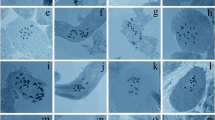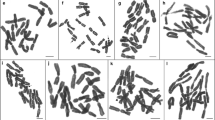Abstract
Chromosome data are important for elucidating intergeneric relationships and delimiting infrafamilial tribes in plants. This paper reports karyological data for 12 Seriphidium (Bess.) Poljak. species from China, of these, five count as new reports and the others have been reported elsewhere. We also report the tetraploid level in S. schrenkianum for the first time. The karyotype formulae and types for the five new reports are: S. schrenkianum (Ledeb.) Poljak. 2n = 4x = 36 = 22m + 12sm + 2st, S. sublessingianum (Kell.) Poljak. 2n = 2x = 18 = 14m + 4sm and S. transiliense (Poljak.) Poljak. 2n = 2x = 18 = 4M + 6m + 2m(SAT) + 4sm + 2sm(SAT), belong to 2A type; S. cinum (Berg. ex Poljak.) Poljak. 2n = 2x = 18 = 8m + 10sm and S. sawanense Y. R. Ling et C. J. Humphries 2n = 2x = 18 = 10m + 2m(SAT) + 6sm, belong to 2B type. Furthermore, we estimated karyotype asymmetry in the 12 species by using an intrachromosomal asymmetry index and an interchromosomal asymmetry index. The data increase information about the karyosystematics of Seriphidium.


Similar content being viewed by others

References
Besser WS (1829) Synopsis Absinthiorum. Bulletin de la Société Impériale des Naturalistes de Moscou 1:219–265
Bremer K, Humphries CJ (1993) Generic monograph of the Asteraceae–Anthemideae. Bull Nat Hist Mus 23(2):71–177
Filatova NS (1975) Caryosystematica nonnullarum halephilus species de Artemisia subgenus Seriphidium (Bess.) Rouy. Bot Hater Ger Inst Bot Akad Nauk Kaz SSR 9:61–67
Garcia S, Garnatje T, Dariimmaa S et al (2006) New or rarely-reported chromosome numbers in taxa of subtribe Artemisiinae (Anthemideae, Asteraceae) from Mongolia. Bot J Linn Soc 150:203–210
Grubov VL (1982) Key to the vascular plants of Mongolia. Sciences Branch Press, Leningrad
Grubov VL (1984) Florae republicae popularis Mongoliae species endemicae. Nov Sys PI Vascaul 21:202–220
He XL, Zhang MJ (2009) Chromosome numbers and karyotype of 7 Species from Seriphidium (Compositae). Acta Bot Boreal Occident Sin 29(6):1155–1161 (in Chinese, with English abstract)
Hong DY (1990) Plant Cytotaxonomy. Science Press, Beijing (in Chinese)
Kornkven AB, Watson LE, Estes JR (1998) Phylogenetic analysis of Artemisia section Tridentatae (Asteraceae) based on sequences from the internal transcribed spaces (ITS) of nuclear ribosomal DNA. Am J Bot 85(12):1787–1795
Levan A, Fredga K, Sandberg AA (1964) Nomenclature for centromeric position on chromosomes. Hereditas 52:201–220
Ling YR (1982) On the system of the genus Artemisia Linn. and the relationship with its allies. Bullet Bot Res 2(2):1–60 (in Chinese, with English abstract)
Ling YR (1995) The new world Seriphidium (Besser) Fourr. In: Hind DJN, Jeffrey C, Pope GV (eds) Advances in Compositae systematics. Roy Bot Gard Kew, UK, pp 283–291
McArthur ED, Pope CL, Freeman DC (1981) Chromosomal studies of subgenus Tridentatae of Artemisia: evidence for autopolyploidy. Am J Bot 68:589–605
McArthur ED, Stewart CS, Erson (1999) Cytogeography and chromosome evolution of subgenus tridentatae of Artemisia (Asteraceae). Am J Bot 6(12):1754–1775
Oliva M, Vallès J (1994) Karyological studies in some taxa of the genus Artemisia (Asteraceae). Can J Bot 72:1126–1135
Pellicer J, Garcia S, Garnatje T et al (2007) Chromosome counts in Asian Artemisia L. (Asteraceae) species: from diploids to the first report of the highest polyploid in the genus. Bot J Linn Soc 153:301–310
Raven PH (1975) The bases of angiosperm phylogeny: cytology. Ann Missouri Bot Gard 62:724–764
Romero ZC (1986) A new method for estimating karyotype asymmetry. Taxon 35:526–530
Rydberg PA (1916) Artemisia and Artemisiastrum. North Am Flor 34:244–285
Schweizer D, Ehrendorfer F (1983) Evolution of C-band patterns in Asteraceae–Anthemideae. Biologisches Zentralblatt 102:637–655
Solbrig OT (1977) Chromosomal cytology and evolution in the family Compositae. In: Heywood VH, Harborne JB, Turner BL (eds) The biology and chemistry of the Compositae, vol I. Academic Press, London, pp 269–281
Stebbins GL (1971) Chromosome evolution in higher plants. Edward Arnold, London
Torrell M, Cerbah M, Siljak-yakovlev S et al (2003) Molecular cytogenetics of the genus Artemisia (Asteraceae, Anthemideae): fluorochrome banding and fluorescence in situ hybridization.I. Subgenus Seriphidium and related taxa. Plant Syst Evol 239:141–153
Vallès J, Siljak-yakovlev S (1997) Cytogenetic studies in the genus Artemisia L.: fluorochrome banded karyotypes of five taxa, including the Iberian endemic species Artemisia barrelieri Besser. Can J Bot 75:595–606
Weber WA (1984) The western North American woody sagebrushes. Phytologia 55:7–8
Acknowledgments
This research work was supported by National Natural Science Foundation of China (grant no.30470133).
Author information
Authors and Affiliations
Corresponding author
Rights and permissions
About this article
Cite this article
Zhang, Mj., He, Xl. Chromosome numbers and karyotype of five species from Seriphidium (Asteraceae). Plant Syst Evol 290, 109–113 (2010). https://doi.org/10.1007/s00606-010-0353-7
Received:
Accepted:
Published:
Issue Date:
DOI: https://doi.org/10.1007/s00606-010-0353-7



